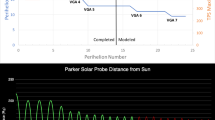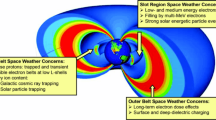Abstract
An electric solar wind sail uses the natural solar wind stream to produce low but continuous thrust by interacting with a number of long thin charged tethers. It allows a spacecraft to generate a thrust without consuming any reaction mass. The aim of this paper is to investigate the use of a spacecraft with such a propulsion system to deflect an asteroid with a high relative velocity away from an Earth collision trajectory. To this end, we formulate a simulation model for the electric solar wind sail. By summing thrust vectors exerted on each tether, a dynamic model which gives the relation between the thrust and sail attitude is proposed. Orbital maneuvering by fixing the sail’s attitude and changing tether voltage is considered. A detailed study of the deflection of fictional asteroids, which are assumed to be identified 15 years before Earth impact, is also presented. Assuming a spacecraft characteristic acceleration of 0.5 mm/s 2, and a projectile mass of 1,000 kg, we show that the trajectory of asteroids with one million tons can be changed enough to avoid a collision with the Earth. Finally, the effectiveness of using this method of propulsion in an asteroid deflection mission is evaluated in comparison with using flat photonic solar sails.















Similar content being viewed by others
References
Alvarez, L. W., Alvarez, W., Asaro, F., Michael, H. V.: Extra-terrestrial cause for the cretaceous-tertiary extinction. Science 208(4448), 1095–1108 (1980). doi:10.2307/1683699
Binzel, R.P.: The torino impact hazard scale. Planetary and Space Science 48, 297–303 (2000). doi:10.1016/S0032-0633(00)00006-4
Carry, B.: Density of asteroids. Planetary and Space Science 73(1), 98–118 (2012). doi:10.1016/j.pss.2012.03.009
Chapman, C. R., Morrison, D.: Impact on the Earth by asteroids and comets: Assessing the hazard. Nature 367(6458), 33–39 (1994). doi:10.1038/367033a0
Chyba, C. F., Thomas, P. J., Zahnle, K. J.: The 1908 Tunguska explosion: Atmospheric disruption of a stony asteroid. Nature 361, 40–44 (1993). doi:10.1038/361040a0
Dachwald, B., Wie, B.: Solar sail kinetic energy impactor trajectory optimization for an asteroid-deflection mission. J. Spacecr. Rocket. 44(4), 755–764 (2007). doi:10.2514/1.22586
Envall, J., Janhunen, P., Toivanen, P., Pajusalu, M., Ilbis, E., Kalde, J., Averin, M., Kuuste, H., Laizans, K., Allik, V., Rauhala, T., Seppänen, H., Kiprich, S., Ukkonen, J., Haeggstrom, E., Kalvas, T., Tarvainen, O., Kauppinen, J., Nuottajärvi, A., Koivisto, H.: E-sail test payload of the ESTCube-1 nanosatellite. In: Proceedings of the Estonian Academy of Sciences (2014)
Ivashkin, V., Smirnov, V.: An analysis of some methods of asteroid hazard mitigation for the earth. Planetary and Space Science 43(6), 821–825 (1995). doi:10.1016/0032-0633(94)00225-G
Izzo, D.: Optimization of interplanetary trjectories for impulsive and continuous asteroid deflection. J. Guid. Control. Dyn. 30(2), 401–408 (2007). doi:10.2514/1.21685
Izzo, D., de Negueruela, C., Ongaro, F., Walker, R.: Strategies for near earth object impact hazard mitigation. In: Proceedings of the Space Flight Mechanics Conference, AAS, Copper Mountain, Colorado (2005)
Janhunen, P.: Electric sail for spacecraft propulsion. J. Propuls. Power 20(4), 763–764 (2004). doi:10.2514/1.8580
Janhunen, P.: The electric sail - a new propulsion method which may enable fast missions to the outer solar system. J. Br. Interplanet. Soc. 61, 322–325 (2008)
Janhunen, P.: Increased electric sail thrust through removal of trapped shielding electrons by orbit chaotisation due to spacecraft body. Ann. Geophys. 27(8), 3089–3100 (2009). doi:10.5194/angeo-27-3089-2009
Janhunen, P., Sandroos, A.: Simulation study of solar wind push on a charged wire: Basis of solar wind electric sail propulsion. Ann. Geophys. 25(3), 755–767 (2007). doi:10.5194/angeo-25-755-2007
Janhunen, P., Toivanen, P. K.: Electric sailing under observed solar wind conditions. Astronautics and Space Sciences 5, 61–69 (2019)
Janhunen, P., Quarta, A. A., Mengali, G.: Electric solar wind sail mass budget model. Geocentric Instrumentation Methods and Data Systems 2, 85–95 (2013). doi:10.5194/gi-2-85-2013
Khurshid, O., Tikka, T., Praks, J., Hallikainen, M.: Accomodating the plasma brake experimant on-board the aalto-1 satellite. In: Proceedings of the Estonian Academy of Sciences (2014)
Lu, E. T., Love, S.: Gravitational tractor for towing asteroids. Nature 438, 177 (2005). doi:10.1038/438177a
McInnes, C. R.: Solar sailing; technology, dynamics and mission applications 2, 32–55 (1999)
Mengali, G., Quarta, A. A.: Optimal nodal flyby with near-Earth asteroids using electric sail. Acta Astronautica 104, 450–457 (2014). doi:10.1016/j.actaastro.2014.02.012
Mengali, G., Quarta, A. A., Janhunen, P.: Electric sail performance analysis. J. Spacecr. Rocket. 45(1), 122–129 (2007). doi:10.2514/1.31769
Quarta, A. A., Mengali, G.: Electric sail mission analysis for outer solar exploration. J. Spacecr. Rocket. 33(3), 740–755 (2008). doi:10.2514/1.47006
Quarta, A.A., Mengali, G.: Electric sail missions to potentially hazardous asteroids. Acta Astronautica 66, 1506–1519 (2013). doi:10.1016/j.actaastro.2009.11.021
Quarta, A. A., Mengali, G., Janhunen, P.: Electric sail for a near-earth asteroid sample return mission: Case 1998 ky26. J. Aerosp. Eng. 27(6) (2014). doi:10.1061/(ASCE)AS.1943-5525.0000285
Rabinowitz, D., Helin, E., Lawrence, K., Pravdo, S.: A reduced estimate of the number of kilometre-sized near-earth asteroids. Nature 403(6766), 165–166 (2000). doi:10.1038/35003128
Sittler, E. C., Scudder, J. D.: An empirical polytrope law for solar wind thermal electrons between 0.45 and 4.76 au: Voyager and mariner 10. J. Geophys. Res. 85, 5131–5137 (1980). doi:10.1029/JA085iA10p05131
Slavin, J. A., Holzer, R. E.: Solar wind flow about the terrestrial planets, 1. modeling bow shock position and shape. J. Geophys. Res 418(11), 11, 401–11 (1981). doi:10.1029/JA086iA13p11401
Slavinskis, A. M.P., Kuuste, H., Ilbis, E., Eenmäe, T., Sünter, I., ans, K. L., Ehrpais, H., Liias, P., Kulu, E., Viru, J., Kalde, J., Kvell, U., Kütt, J., Zälite, K., Kahn, K., Lätt, S., Envall, J., Toivanen, P., Polkko, J., Janhunen, P., Rosta, R., Kalvas, T., Vendt, R., Allik, V., Noorma, M.: ESTCube-1 in-orbit experience and lessons learned. IEEE Aerospace and Electronics Systems Magazine 30(8), 13–22 (2015). doi:10.1109/MAES.2015.150034
Toivanen, P. K., Janhunen, P.: Spin plane control and thrust vectoring of electric solar wind sail. J. Propuls. Power 29(1), 178–185 (2013). doi:10.2514/1.B34330
Vasile, M., Colombo, C.: Optimal impact strategies for asteroid deflection. J. Guid. Control. Dyn. 31(4), 858–872 (2008). doi:10.2514/1.33432
Vasilyev, N.V.: The Tunguska meteorite problem today. Planet Space Science 46(2/3), 129–150 (1998). doi:10.1016/S0032-0633(97)00145-1
Wie, B.: Solar sail kinetic energy impactor (KEI) mission for impacting/deflecting near-earth asteroids. In: 41st AIAA/ASME/SAE/ ASEE Joint Propulsion Conference and Exhibit, AIAA, Tucson, AZ (2005)
Wright, J.: Space Sailing, pp 227–233. Gordon and Breach Science Publisher (1992)
Yamaguchi, K., Yamakawa, H.: Orbital maneuver of electric sail using on/off thrust control. Koku-Uchu-Gijyutsu(Aerospace Technology Japan, the Japan Society for Aeronautical and Space Sciences) 12:79–88 (2013)
Acknowledgements
The present study was supported by JSPS KAKENHI Grant Number 15J08268.
Author information
Authors and Affiliations
Corresponding author
Rights and permissions
About this article
Cite this article
Yamaguchi, K., Yamakawa, H. Electric Solar Wind Sail Kinetic Energy Impactor for Asteroid Deflection Missions. J of Astronaut Sci 63, 1–22 (2016). https://doi.org/10.1007/s40295-015-0081-x
Published:
Issue Date:
DOI: https://doi.org/10.1007/s40295-015-0081-x




